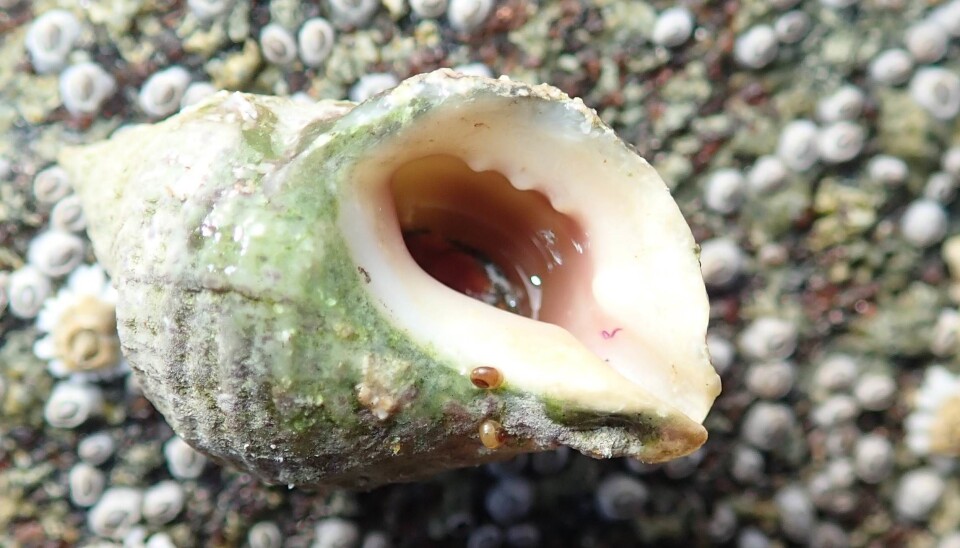An article from NIVA - Norwegian Institute for Water Research

Restriction on pollution helps: Infertile snails have recovered along the Norwegian coast
For 27 years, NIVA has monitored TBT and reproductive disorder – so called imposex – in dogwhelk along the Norwegian coastline.
The environmental pollutant TBT (tributyltin) can mimic hormones to the extent that it sterilizes female snails and make them grow non-functional penises and vas deferens.
But for the first time since monitoring started up in 1991 and the total ban of TBT entered into force in 2008, only fertile dogwhelk have been found along the Norwegian coastline.
"This is an excellent example that restrictions on pollutants certainly helps," says marine biologist and researcher Merete Schøyen from the Norwegian Institute of Water Research (NIVA).
For 27 years, NIVA has monitored TBT and reproductive disorder – so called imposex – in dogwhelk along the Norwegian coastline. NIVA has unique data on the levels and trends of the pollutant and its effects on dogwhelk populations in Norway. The results are published in a scientific paper and in NIVA’s research report to the Norwegian Environmental Agency.
A unique health indicator
The dogwhelk is abundant on the shore along the entire Norwegian coastline in more wave exposed area, and in this regard, is especially suitable for monitoring the biological effect of TBT.
"The measure of imposex is a very good and easy biological measure of the chemical impact," says Schøyen.
"The severity of the TBT pollution in female dogwhelk can be seen with the naked eye, and can be easily assessed by measuring the length of the penis and the developmental stage of the vas deferens," she Schøyen.
The TBT and imposex monitoring of dogwhelk is part of the NIVA monitoring program 'Contaminants in coastal waters of Norway,' commissioned by the Norwegian Environmental Agency, and has been running since the early 1980s.
One boat, one snail
TBT was previously used in antifouling ship paints. In contact with water, TBT leaked from the paint and mixed with ocean water. In highly trafficked sounds and canals, like Færder in the outer Oslofjord, and in Karmsundet close to Haugesund, the levels of TBT built up to high concentrations.
"Dogwhelk are especially vulnerable to TBT; it takes just 1 nannogram per litre of sea water to harm the snail. This could be attributed to just one freight ship with TBT-containing antifouling paint sailing by," says Schøyen.
Dogwhelk accumulate TBT by eating blue mussel and barnacles, both of which are filter feeders. Because TBT has an affinity to attach to biological materials and particles in the sea water, it can be easily taken up by organisms that filter sea water for food.
Affects the hormone balance
TBT in female dogwhelk effects the balance of oestrogen and androgen hormones. As a result, a female dogwhelk can develop a penis vas deferens. In the most severe cases, the vas deferens completely covers the vaginal opening, and the snail becomes sterile, unable to lay eggs and reproduce. This effect is irreversible for the individual, and may potentially reduce the population size.
"Local dogwhelk populations over large areas in the North Atlantic Ocean have been severely reduced due to imposex and female sterility resulting from TBT pollution," Schøyen says.
But those times have passed.
Banning TBT explains improvement
In 2017, Schøyen and her colleagues at NIVA could not find a single case of imposex in dogwhelk for the first time since monitoring began in 1991.
Schøyen finds it particularly interesting to see the prevalence of imposex in relation to the years when the various TBT restrictions entered finto orce.
"The synchronous decrease in both TBT concentrations and imposex in dogwhelk coincides with the TBT bans. The use of TBT was prohibited for marine vessels shorter than 25 meters in length in 1990. This lead to a decrease in TBT levels in dogwhelk, but the degree of reproductive disorder remained high. Decreased imposex was not evident until the restrictions were extended to vessels longer than 25 m in 2003. After the total TBT-ban in 2008, the occurrence of imposex stayed low," she exsays.
Important long-term monitoring
Even if the TBT ban has undoubtedly been a success, NIVA is not yet done with their investigations of dogwhelk. They will continue monitoring until 2020.
"Long time series are valuable for the management because time trend analyses can give an early warning of unwanted change. The authorities need strong scientific evidence to make good regulatory decisions. Long-term monitoring provides a basis for judging the success of environmental policy and regulations," says Schøyen.
Downward trends in TBT concentrations is also evident in blue mussel. But even if the direct emissions of TBT from ships and land sources have ceased, the problem of TBT impact on organism is not gone. Leakage of TBT from sediments and certain landfills may persist for decades. This year’s sampling of dogwhelk is already done.
"I am excited to see if the levels stay low in the future," she says.
---------------
The monitoring of contaminants in coastal waters of Norway is conducted by NIVA on commission by the Norwegian Environment Agency through the Oslo-Paris Convention (OSPAR). The results are reported to the EU through the Water Framework Directive.






























